Definition: Group dynamics is the analysis of all those factors which contribute to the creation and functioning of a group. It is moreover concerned about the change in psychology or mindset of the individuals while performing in a group. It is a parameter to evaluate the overall performance of a group.
Also, it examines the impact of various elements such as group structure, development, decision making, principles and threats over the performance of the group.
Content: Group Dynamics
Factors Affecting Group Dynamics
According to Malcolm and Hudla Knowles, the following four eminent aspects influence the group dynamics significantly: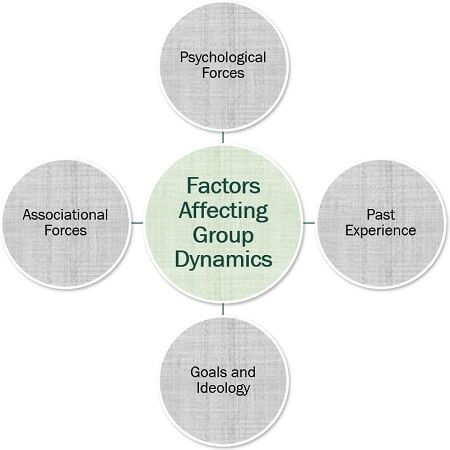
Psychological Forces: The psychology or desires of the individuals revolve around their need for status, security, recognition, experience and belongingness. All this affects their adaptability to the group.
Past Experience: An individual’s behaviour in a group depends upon his/her learning from the past events of life comprising of the habits, values, attitude, perception etc.
Goals and Ideology: Another essential component is the individual’s goals and beliefs which may or may not align with that of the whole group, leading to disagreement and unwillingness to perform.
Associational Forces: The associational factors, i.e., the impact of family, geographical habitation, peers group, traditions, customs and religion on the individual; direct his/her actions in a group.
Group Structure
A group (and here we are talking about a workgroup) is a well planned and systematic collection of individuals for goal achievement.
Every group has a specified structure, i.e., the size, status, roles, norms and cohesiveness of the group are outlined well in advance to avoid any confusion during task accomplishment.
Let us now find out the inclusions of all these elements of group structure: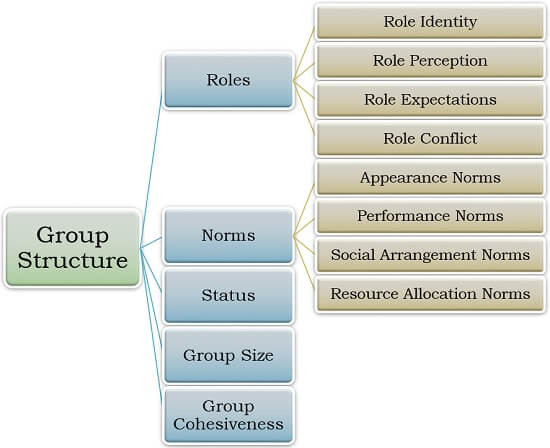
Group Roles
A defined manner in which an individual is supposed to behave while holding a particular position in the group can be termed as his/her role. It comprises of the following:
- Role Identity: The set of behaviour or attitude defining the role of a particular position;
- Role Perception: How an individual interprets his/her role in the group or the organization;
- Role Expectations: Anticipation of the individual’s role in the team by the other group members;
- Role Conflict: Whenever the roles of two or more group members are not adequately specified or clash with one another, there is a situation of role conflict.
Group Norms
These are the specified rules and guideline to act in a desired manner. Given below is the different classes of group norms set in an organization:
- Appearance Norms: The group together decides the attire and presentability of its members;
- Performance Norms: The guidelines for the desired level of contribution and expected results are defined;
- Social Arrangement Norms: Also, the norms for individual interaction and communication within a group are pre-determined;
- Resource Allocation Norms: All the resources such as compensation, tools, equipment and other amenities for task accomplishment, are assigned to the group members as per the specific guidelines.
Group Status
The status here means the position or reputation of a group within the organization.
A group which is recognized throughout the company for its achievement, teamwork and cohesiveness, holds better goodwill or high status.
Therefore, the workers show more interest in becoming a part of such a group.
Also, the existing group members tend to possess a higher degree of loyalty towards their teammates, which strengthens this high-status group even more.
Group Size
The size of the group is an essential component while understanding group dynamics. It can be seen as follows:
Small Group: We know that small groups comprising of three to ten individuals are more functional than the larger ones. It facilitates better discussion, higher satisfaction and individual’s participation for effective decision making.
Large Group: The huge groups comprise more than ten people encounter issues like delay in decision making, lack of participation of all the members, dissatisfaction and lack of belongingness among the group members.
Group Cohesiveness
The cohesion or intactness of the group members shows the level of bonding they share. Let us now understand the various elements of group cohesiveness:
- Task relations refer to the interaction of individuals in a group for the accomplishment of the assigned work;
- Social relations, i.e., the interaction of the group members on a personal level;
- Emotions can be seen as the feelings shared by the group members.
Group Development
Group development is the process of engaging unfamiliar individuals into a capable team or group for the accomplishment of a specific task.
At every stage of group development, there is a change in the individuals’ attitude, perception and behaviour.
5 Stages of Group Development
The process of group development begins at the pre-stage where all the prospective group members are unaware of their compilation into a group. Given below are the Tuckman’s five stages following the pre-stage: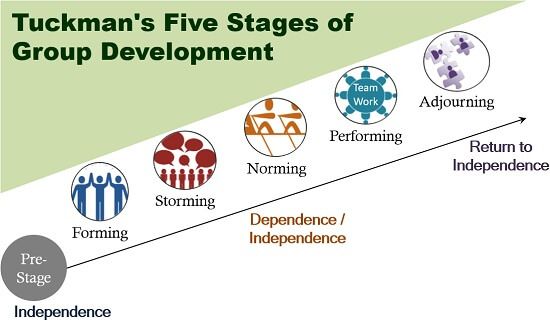
Forming: This is the very first phase after pre-stage, where the individuals in a group are made a part of the group. Moreover, they are familiarized with one another. Here, the individuals are unclear about the goal and direction.
Storming: At this stage, the group members start interacting with one another, only to find out that their views are very different, and each one of them tries to prove oneself right. There is a different environment in the group where everyone battle to acquire power.
Norming: This is the phase where understanding and coordination develop among the team members, and they try to work unanimously. Everyone is clear about his/her task or role in the group.
Performing: At this stage, the group members become highly active and work together for goal accomplishment.
Adjourning: This is the final phase of this process, where the task is fulfilled. The efforts of the whole team are recognized, and then the group may be adjourned.
Group Decision Making
When it comes to group decision making, the leader should provide a fair chance for every member to put forward their thoughts and ideas. Some of the best ways which can be adopted are as follows: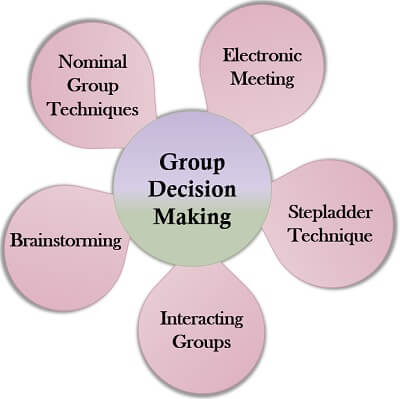
- Brainstorming: Taking the view or input from each individual of the group;
- Stepladder Technique: Involving a new member and letting that person provide his/her suggestions;
- Electronic Meeting: For the groups comprising of people from different locations e-meetings are carried out to take their views;
- Interacting Groups: The individuals in a group are engaged in group discussion for problem-solving;
- Nominal Group Techniques: The group members are clustered into smaller teams for a systematic presentation of their idea or solution; after which each of the individual votes for his/her most preferred plan.
Principles of Group Dynamics
The group dynamics is all about how a group behaves and acts in a specific situation. Let us now enlist some of the crucial requirements for standardizing the actions of a group:
- Each of the group members should regard and value the thoughts, status or prestige of the other members.
- The members of a group should develop a feeling of unanimity and maintain coordination within the team.
- A group encounters the entry and exit of members and also reformations and dissolution to meet the purpose of the organization.
- The group members need to stick to the norms or rules formed by them collectively.
- Together as a group, the members have the power to achieve the goals more efficiently.
- Everyone in a group aims at a collective objective of task accomplishment, i.e., the group goal.
- The group norms, composition, authority and objectives are altered and redefined to implement the change.
- The group members should ensure that the activities are performed uninterruptedly.
- The actions and duties of the members are directed towards the group goal or objective.
Threats to Group Effectiveness
What makes a group ineffective? Why do a group fail to perform in the desired manner?
A group is made up of people with different mindsets and behaviour. Following are some of the significant reasons for which the workgroups tend to under-perform the given task: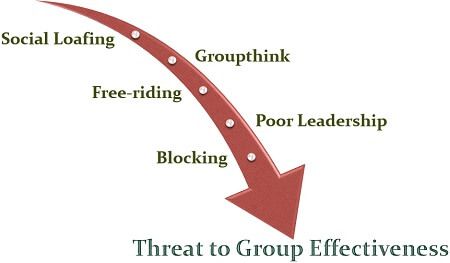
Social Loafing
If even one of the group members tend to become reluctant and under-performs the given task, the chances are that the other members need to put in extra efforts for completing the project.
All of this may result in social loafing, which ultimately leads to poor teamwork and ineffective group efforts.
Groupthink
A group decision which is taken in hustle or without much of discussion may create havoc for the whole team.
It usually results in biased decision making, lack of a backup plan, limited alternatives, declining expert advice and improper revaluation of the various possibilities.
Poor Leadership
Another significant risk to the group functioning is the improper guidance or direction to the members.
If the group leader lacks the sufficient skills of management, then the team members may not be able to rely on his/her decisions.
Free-riding
The person who tends to keep himself/herself away from the task, i.e., a non-performing worker is called a free-rider. Such a person is just like a weed in a heap of a crop. Neither he/she contributes to the decision making and nor to the execution of the task.
Blocking
When one of the group members hinders the formal communication, interaction or discussion within the team, he/she is considered to carry out the blocking role. Some of the significant types of blockers include:
The dominator or recognition seeker is the person who tries to rule or dominate the discussion.
The negativist is one who questions or disagrees with the view of others.
The aggressor is the member who tends to argue with the other members during discussion.
The joker is that individual who injects humour in irrelevant time while the discussion is going on.
The withdrawer usually tries to keep himself/herself away from the discussions or does not engage in the formal interaction.
The interrupter is the group member who is usually busy distracting others with unproductive conversations or gossips.
Conclusion
It is essential that the group leader attentively plans and monitors all the specified dimensions to attain strong group dynamics.
There should be a perfect blend of talent and efforts in a group to make it efficient. Also, the roles, responsibilities, duties, task and authority should be smartly distributed among the group members.
A well designed and managed group dynamics is the key to a high-status group.
Also, to better understand the group dynamics, it is necessary to have an idea of different types of groups formed in an organization.
divya says
can I get the reference of this article.